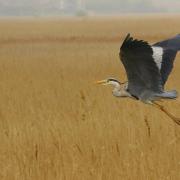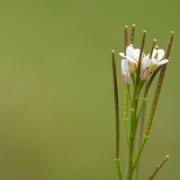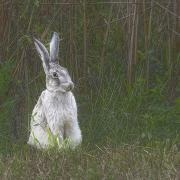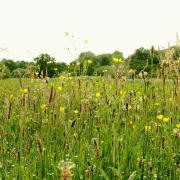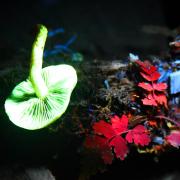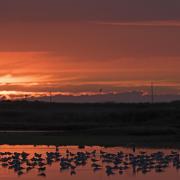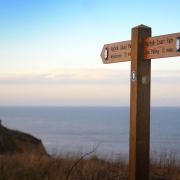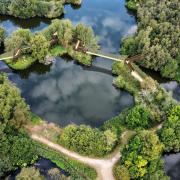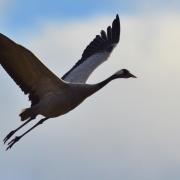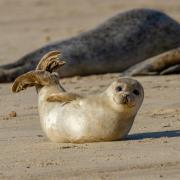Giant service station for great migration
Here in the UK, Norfolk is unsurpassed as a bird-watching destination and October is one of the best months to get a piece of the action, as Sara White explains.
I have good reason for feeling just a little smug about spending time on the Norfolk coast this autumn; in my opinion the beaches are at their best – wild, windswept and dramatic. The marshes seem to glow in the ebbing rays of evening sun and clear skies give an invigorating freshness after the summer fug. The holidaymakers may have gone but in their place comes an altogether more intriguing bunch; the twitchers. In my experience, the twitchers are usually “chasing” some single, rare vagrant bird blown ashore by an easterly wind. Come rain, shine or gale, there’s no mistaking them as they form excited huddles with their telephoto lenses and binoculars. You have to admire their commitment.But you don’t have to be a serious birder to get a kick, like them, out of birdlife this month. One of the greatest wildlife spectacles in Britain happens right here – the arrival of thousands of pink-footed geese from their arctic breeding grounds. More than 240,000 pink-foots spend the winter in the UK – 40pc of them on the Norfolk coast. Dense flocks of birds form spectacularly long lines and classic “V” shapes in the skies over Norfolk from October onwards. They tend to arrive in style too – in triumphant and deafening chorus. They are not the only birds worthy of a mention; October marks the peak migration month and the county bustles with an estimated third of a million birds. A staggering 300 species have been recorded here.We are perfectly positioned, jutting out into the North Sea and in close proximity to Scandinavia, slap-bang on a migration pathway. Like a giant service station we attract a hugely exciting mix of birdlife. Throngs of winter thrushes, finches and warblers, heading for sunnier southern climes, stop off here, while waves of wildfowl and waders arrive in their thousands to feast on the Wash, England’s largest tidal estuary and a vital winter foraging ground.Norfolk is blessed with wildlife reserves and whether you head to the coast for the sheer volume and drama of the pink-foots, or choose to visit one of the inland reserves, offering equally rewarding but more low-key wildlife encounters, you won’t be disappointed. Some of the best places are listed right. My recommendation for an October evening: rug up warm, savour the sights and sounds and then head for a pub, preferably one with a blazing log fire.TOP 10 RECOMMENDED RESERVESHolme Bird Observatory & Reserve, managed by the Norfolk Ornithologists’ Association, www.noa.org.ukFive hectares of pine and scrub covered dunes – good for migrating thrushes, warblers and finches. An impressive 50,000 birds have been ringed here. �3 each for non-members, under 16s free. Holkham National Nature Reserve, managed by English Nature, www.holkham.co.uk This consists of 4,000 hectares stretching from Burnham Norton to Blakeney. The Norfolk Coast Path links the three car parks at Burnham Overy, Lady Ann’s Drive and Wells Beach Road. Offers fantastic diversity of habitat and wildlife with accessible trails and jaw-dropping beach walks. Seasonal parking charges apply.The National Trust’s Blakeney National Nature Reserve, 01263 740241.Highlights include Stiffkey Marshes and Blakeney Point, a three-and-a-half mile long sand and shingle spit. Large numbers of birds congregate here. Information centre and tearoom at Morston Quay. Open year-round, pay and display car-parking for non-members.Norfolk Wildlife Trust Cley Marshes,01263 740008. England’s oldest bird reserve, founded in 1926. Boardwalks and hides within metres of the bird pools. On a chilly day, the award-winning, environmentally friendly visitor centre and caf� is an excellent option – sit by the panoramic windows with a bowl of steaming soup and enjoy the view. Open year-round, NWT members and children free, non-members �3.75.Norfolk Wildlife Trust’s Hickling Broad,01692 598276. The 600 hectares of Hickling Broad combine open reedbed, fen, grazing marsh and woodland with boardwalks and hides. There are 30 cranes in residence here and the raptor roost at Stubb Mill gives fantastic views of hen and marsh harriers coming in to roost at dusk.Non-members �3.50, children free.RSPB Berney Marshes and Breydon Water, near Yarmouth, 01493 700645. Up to 100,000 wintering wildfowl and waders gather here by mid-winter. To access the centre of the reserve, take the train to Berney Arms station.Open year-round, free entry.RSPB Strumpshaw Fen,01603 715191. Lovely circular walks through reedbeds and woodland. Good opportunities to see hen and marsh harriers gathering here to roost as well as large numbers of ducks.Open dawn to dusk daily, non-members �2.50 adults; 50p children; �1.50 concessions and �5 families.Snettisham RSPB Reserve, 01485 542689. Bird hides looking out on to the islands and roost banks of the Wash. Excellent for seeing waders and wildfowl.Open year-round, free entry.Titchwell Marsh RSPB Reserve, 01485 210779. Brilliant for waders and wildfowl. Very accessible for novices. Visitor centre, caf� and plentiful hides and walks.Open year-round, �4 per car for non-members.Winterton Dunes National Nature Reserve, managed by English Nature.108 hectares of wild and windswept dunes, offering shelter to many migrant birds such as wheatears and warblers. Glorious beach. Large car park, caf� and toilet block.
A GUIDE TO TWITCHER TWITTERA twitcher: Someone who travels a long way to see a rare bird and tick it off their “list”.Mega: A very rare bird.To dip out: To miss seeing a bird.Dude: A demeaning term for a novice birdwatcher who has “all the gear but no idea”. Stringer: Someone who habitually misidentifies birds.List: List of all species seen, sometimes a “life list”.Plastic: A bird escaped from captivity, not a wild bird.Sibe: A bird from Siberia.



